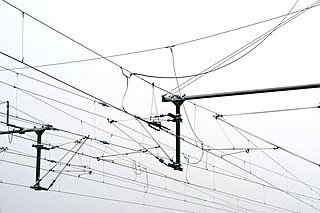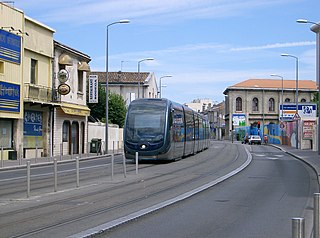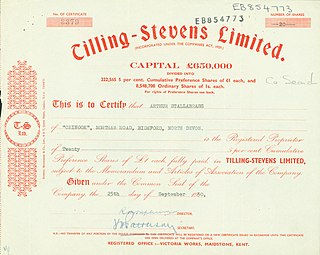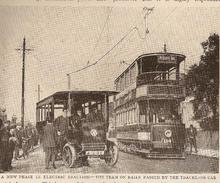
A trolleybus is an electric bus that draws power from dual overhead wires using spring-loaded trolley poles. Two wires, and two trolley poles, are required to complete the electrical circuit. This differs from a tram or streetcar, which normally uses the track as the return path, needing only one wire and one pole. They are also distinct from other kinds of electric buses, which usually rely on batteries. Power is most commonly supplied as 600-volt direct current, but there are exceptions.

An overhead line or overhead wire is an electrical cable that is used to transmit electrical energy to electric locomotives, trolleybuses or trams. It is known variously as:

An electric vehicle (EV) is a vehicle that uses one or more electric motors for propulsion. It can be powered by a collector system, with electricity from extravehicular sources, or it can be powered autonomously by a battery. EVs include, but are not limited to, road and rail vehicles, surface and underwater vessels, electric aircraft and electric spacecraft.

Regenerative braking is an energy recovery mechanism that slows down a moving vehicle or object by converting its kinetic energy into a form that can be either used immediately or stored until needed. In this mechanism, the electric traction motor uses the vehicle's momentum to recover energy that would otherwise be lost to the brake discs as heat. This method contrasts with conventional braking systems. In those systems, the excess kinetic energy is converted to unwanted and wasted heat due to friction in the brakes, or with rheostatic brakes, where the energy is recovered by using electric motors as generators but is immediately dissipated as heat in resistors. In addition to improving the overall efficiency of the vehicle, regeneration can significantly extend the life of the braking system as the mechanical parts will not wear out quickly.

Dynamic braking is the use of an electric traction motor as a generator when slowing a vehicle such as an electric or diesel-electric locomotive. It is termed "rheostatic" if the generated electrical power is dissipated as heat in brake grid resistors, and "regenerative" if the power is returned to the supply line. Dynamic braking reduces wear on friction-based braking components, and regeneration lowers net energy consumption. Dynamic braking may also be used on railcars with multiple units, light rail vehicles, electric trams, trolleybuses, and electric and hybrid electric automobiles.

A railway electrification system supplies electric power to railway trains and trams without an on-board prime mover or local fuel supply. Electric railways use either electric locomotives, electric multiple units or both. Electricity is typically generated in large and relatively efficient generating stations, transmitted to the railway network and distributed to the trains. Some electric railways have their own dedicated generating stations and transmission lines, but most purchase power from an electric utility. The railway usually provides its own distribution lines, switches, and transformers.

Ground-level power supply, also known as surface current collection or, in French, alimentation par le sol, is a concept and group of technologies whereby electric vehicles collect electric power at ground level from individually-powered segments instead of the more common overhead lines. Ground-level power supply has been used primarily for aesthetic reasons. During the late 2010s it has become more economical than overhead lines.
Hybrid Synergy Drive (HSD), also known as Toyota Hybrid System II, is the brand name of Toyota Motor Corporation for the hybrid car drive train technology used in vehicles with the Toyota and Lexus marques. First introduced on the Prius, the technology is an option on several other Toyota and Lexus vehicles and has been adapted for the electric drive system of the hydrogen-powered Mirai, and for a plug-in hybrid version of the Prius. Previously, Toyota also licensed its HSD technology to Nissan for use in its Nissan Altima Hybrid. Its parts supplier Aisin Seiki Co. offers similar hybrid transmissions to other car companies.

Conduit current collection is an obsolete system of electric current collection used by some electric tramways, where the power supply was carried in a 'conduit' under the roadway. Modern systems fall under the term ground-level power supply.

Tilling-Stevens was a British manufacturer of buses and other commercial vehicles, based in Maidstone, Kent. Originally established in 1897, it became a specialist in petrol-electric vehicles. It continued as an independent manufacturer until 1950, when it was acquired by the Rootes Group.
Hybrid vehicle drivetrains transmit power to the driving wheels for hybrid vehicles. A hybrid vehicle has multiple forms of motive power.
The stud contact system is an obsolete ground-level power supply system for electric trams. Power supply studs were set in the road at intervals and connected to a buried electric cable by switches operated by magnets on the tramcars. Current was collected from the studs by a "skate" or "ski collector" under the tramcar. The system was popular for a while in the early 1900s but soon fell out of favour because of the unreliability of the magnetic switches, largely due to friction and rapid corrosion affecting its cast iron moving components.

A battery electric vehicle (BEV), pure electric vehicle, only-electric vehicle, fully electric vehicle or all-electric vehicle is a type of electric vehicle (EV) that exclusively uses chemical energy stored in rechargeable battery packs, with no secondary source of propulsion. BEVs use electric motors and motor controllers instead of internal combustion engines (ICEs) for propulsion. They derive all power from battery packs and thus have no internal combustion engine, fuel cell, or fuel tank. BEVs include – but are not limited to – motorcycles, bicycles, scooters, skateboards, railcars, watercraft, forklifts, buses, trucks, and cars.
Electric current collectors are used by trolleybuses, trams, electric locomotives or EMUs to carry electrical power from overhead lines, electrical third rails, or ground-level power supplies to the electrical equipment of the vehicles. Those for overhead wires are roof-mounted devices, those for rails are mounted on the bogies. Current collectors are also electric bridging components that collect electrical current generated at the electrodes of electrochemical devices, such as lithium-class battery cells, and connect with external circuits.

Resonant inductive coupling or magnetic phase synchronous coupling is a phenomenon with inductive coupling where the coupling becomes stronger when the "secondary" (load-bearing) side of the loosely coupled coil resonates. A resonant transformer of this type is often used in analog circuitry as a bandpass filter. Resonant inductive coupling is also used in wireless power systems for portable computers, phones, and vehicles.

Torquay Tramways operated electric street trams in Torquay, Devon, England, from 1907. They were initially powered by the unusual Dolter stud-contact electrification, but in 1911 was converted to more conventional overhead-line supply. The line was extended into neighbouring Paignton in 1911 but the whole network was closed in 1934.
This glossary of electrical and electronics engineering is a list of definitions of terms and concepts related specifically to electrical engineering and electronics engineering. For terms related to engineering in general, see Glossary of engineering.

Sunbeam Commercial Vehicles was a commercial vehicle manufacturing offshoot of the Wolverhampton based Sunbeam Motor Car Company when it was a subsidiary of S T D Motors Limited. Sunbeam had always made ambulances on modified Sunbeam car chassis. S T D Motors chose to enter the large commercial vehicle market in the late 1920s, and once established they made petrol and diesel buses and electrically powered trolleybuses and milk floats. Commercial Vehicles became a separate department of Sunbeam in 1931.
There are numerous versions of vehicle propulsion systems. Many of those came into fruition due to need for cleaner vehicles. Each of them might have many abbreviations and some might be misleading. This article explains shortly what defines them.
















